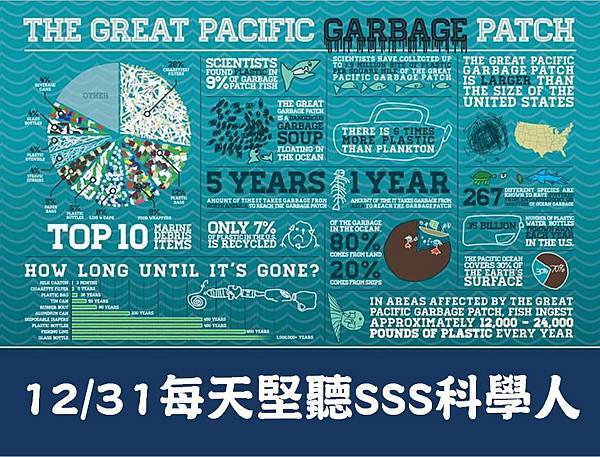
 今日主題:Ocean Plastic Particles Could Get in Gills
今日主題:Ocean Plastic Particles Could Get in Gills
海洋裡的塑膠微粒可以隱藏在魚鰓裡
 洪欣老師推薦:托福聽力最好的課外教材:60-Second Science
洪欣老師推薦:托福聽力最好的課外教材:60-Second Science
 康康精選托福會考的主題,堅持每天精聽一定會進步的哦!!
康康精選托福會考的主題,堅持每天精聽一定會進步的哦!!
 建議方法:
建議方法:
1. 先聽兩三遍 (不看文稿)
2. 再一句一句聽寫 (每句都要聽寫數遍,直到寫出85%以上的字)
3. 最後check文稿,看哪聽不出來,單字沒背過,還是發音不熟。
4. 堅持天天聽,就能每天進步哦。
 MP3音檔 (按右鍵可下載聽):喜歡的同學,幫忙推或按讚哦~~
MP3音檔 (按右鍵可下載聽):喜歡的同學,幫忙推或按讚哦~~
http://online1.tingclass.net/voaspe/…/20140731sa_science.mp3
 只有音檔怎夠,聽不懂地方,不用怕,康康幫你準備好中英文稿了:
只有音檔怎夠,聽不懂地方,不用怕,康康幫你準備好中英文稿了:
 中英文稿:
中英文稿:
There are now at least five major garbage patches in the world's oceans, and much of that trash is plastic. But last month researchers said they can only account for one percent of the plastic they'd expect to find in the oceans. So, where'd the rest of it go?
現在在全世界的大洋中至少有五大主要的垃圾帶,而且絕大多數垃圾是塑膠。但是上個月研究人員稱,他們只能負責處理他們可以在海洋中找到的那百分之一的塑膠,那麼,其他的塑膠都去哪了呢?
Well, animals eat some of it. Plastic has been found in turtles, seabirds, fish, plankton, shellfish, even bottom-feeding invertebrates. But there's another way sea creatures might be accumulating plastic: by sucking up tiny plastic particles with their siphons and gills. You can find more 60-Second Science on chinavoa.com.
好吧,原來是動物會吃一些塑膠。我們可以在烏龜,海鳥,魚,浮游生物,貝類,甚至無脊椎動物身體裡發現塑膠。但是這也有另外一種方法就是,海洋生物可以利用其虹管和魚鰓吸收微小的塑膠顆粒來積累塑膠。
Researchers added common shore crabs—Carcinus maenas—to tanks of seawater containing millions of tiny plastic particles, just 10 microns in diameter.
研究人員將常見的食草蟹—青蟹放在裝滿海水的容器中,容器中的海水中含有成千上萬的直徑只有10微米塑膠粒子。
After 16 hours, all the crabs had plastic lodged in their gills. And the particles stuck around for up to three weeks, too. The results are in the journal Environmental Science and Technology. [Andrew J. R. Watts et al, Uptake and Retention of Microplastics by the Shore Crab Carcinus maenas]
16個小時後,在它們的腮部都會留存有塑膠微粒,而且這些微粒會在其腮部停留三周。該研究結果被發表在《科學與技術》雜誌上。
The longer plastic sits in an animal, researchers say, the better the chances it will travel up the food chain. Meaning all our plastic waste could come back to bite us—or rather be bitten by us.
塑膠在動物身體所待時間越長,就越有可能回到食物鏈中來,這就意味著,我們所扔掉的所有塑膠垃圾可以反過來咬我們一口,或者說我們會食用這些塑膠垃圾。
"Of course we eat mussels whole, without the shells. But we're potentially eating plastic, if they're from a site where there's plastic present." Lead researcher Andrew Watts, of the University of Exeter. "We don't know how much plastic we have in our stomachs… chances are we do have some."
—Christopher Intagliata
“當然我們可以只吃貽貝,它沒有殼。但是我們也很可能吃到塑膠,如果它們來自一個存在塑膠的海域。”埃克塞特大學的首席研究員安德魯•瓦茨說到,“我不知道在我們的胃中有多少塑膠……我們確實可能吃進去一些。”——克裡斯多夫•茵塔利亞塔。


 留言列表
留言列表
